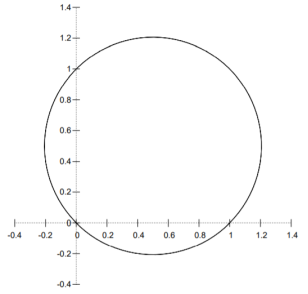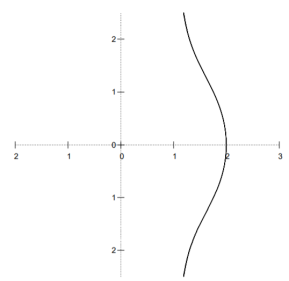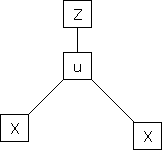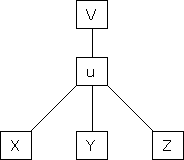Module -1
Partial differentiation
A straight line on a graph that represents a limit for a given function. Imagine a curve that comes closer and closer to a line without actually crossing it.

r = cos(θ) + sin(θ)
This curve has Cartesian equation

The curve is a circle.

r = cos(θ) + sec(θ)
This curve has Cartesian equation x3 + xy2 − 2x2 − y2 = 0 and asymptote x = 1.

Ex.1: Evaluate 0∞ x3/2 e -x dx
Solution: 0∞ x3/2 e -x dx = 0∞ x 5/2-1 e -x dx
= γ(5/2)
= γ(3/2+ 1)
= 3/2 γ(3/2 )
= 3/2 . ½ γ(½ )
= 3/2 . ½ .π
= ¾ π
Ex. 2: Find γ(-½)
Solution: (-½) + 1 = ½
γ(-1/2) = γ(-½ + 1) / (-½)
= - 2 γ(1/2 )
= - 2 π
Ex. 3. Show that 

Solution : =
= 

= 


= 


 ) .......................
) .......................
= 

= 


Ex. 4: Evaluate 
 dx.
dx.
Solution : Let 

 dx
dx
X | 0 |  |
t | 0 |  |
Put  or
or  ;dx =2t dt .
;dx =2t dt .
 dt
dt
 dt
dt



Ex. 5: Evaluate  dx.
dx.
Solution : Let 
 dx.
dx.
x | 0 |  |
t | 0 |  |
Put  or
or  ; 4x dx = dt
; 4x dx = dt
 dx
dx




Definition : Beta function

|
Properties of Beta function : |
2.  |
3.  |
4.  |
Example(1): Evaluate I = 
Solution:







= 2 π/3
Example(2): Evaluate: I = 02 x2 / (2 – x ) . Dx
Solution:
Letting x = 2y, we get
I = (8/2) 01 y 2 (1 – y ) -1/2dy
= (8/2) . B(3 , 1/2 )
= 642 /15
BETA FUNCTION MORE PROBLEMS
Relation between Beta and Gamma functions :
  | ||||||
Example(1): Evaluate: I = 0a x4 (a2 – x2 ) . Dx Solution: Letting x2 = a2 y , we get I = (a6 / 2) 01 y 3/2 (1 – y )1/2dy = (a6 / 2) . B(5/2 , 3/2 ) = a6 /3 2 Example(2): Evaluate: I = 02 x (8 – x3 ) . Dx Solution: Let x3 = 8y I = (8/3) 01 y-1/3 (1 – y ) 1/3 . Dy
= (8/3) B(2/3 , 4/3 ) = 16 π / ( 9 3 ) Example(3): Prove that  Solution : Let   Put            Example(4): Evaluate  Solution :Let  Put      When    
Also             
Example(5): Show that  Solution :  =             Exercise : - Q. Show that 1.   |
Partial Differentiation
If 
Prove that 
Partial differentiation of function of function
If z = f(u) and  . Then z becomes a function of x & y. In this case z becomes a function of function of x & y.
. Then z becomes a function of x & y. In this case z becomes a function of function of x & y.
i.e.

Then
 ,
,



Similarly
If 
Then z becomes a function of function of x, y & z.


 …………….
…………….
- If
 where
where 
Prove that

2. If V =  show that
show that

3. If  show that
show that

4. If  then prove that
then prove that

Let z = f(x, y)

Now for stationary point dz = 0
 &
& 
This gives the set of values of x and y for which maxima or minim occurs
Now find 
We called it as r, s, t resp.
Thus function has maximum or minimum
If rt – s2 >0
i.e. 
Further if
 ; function is minimum at (x, y) &
; function is minimum at (x, y) & ; Function is maximum at (x, y)
; Function is maximum at (x, y)
Note that
- If
 ; then function will not have either maxima or minima such point is called saddle point.
; then function will not have either maxima or minima such point is called saddle point. - If
 ; then more details are required to justly maxima or minima
; then more details are required to justly maxima or minima
Ex. Discuss the stationary values of 
Ex. Find the values of x and y for which x2 + y2 + 6x = 12 has a minimum values and find its minimum value.

Divide 120 into three parts so that the sum of their product. Taken two at a times shall be maximum.
Using Lagrange’s method divide 24 into three parts. Such that continued product of the first, square of second, cube of third may be maximum.
Find the maximum and minimum value of x2 + y2 when 3x2 + 4xy + 6y2 = 140

 is satisfied.
is satisfied.
References
1. Ordinary and Partial Differential equations by J. Sihna Ray and S Padhy, Kalyani Publishers
2. Advance Engineering Mathematics by P.V.O’NEIL, CENGAGE
3. Ordinary Differential Equation by P C Biswal , PHI secondedition.
4. Engineering Mathematics by P. S. Das & C. Vijayakumari, Pearson. N.B:Thecourseisof3creditwith4contacthours.



